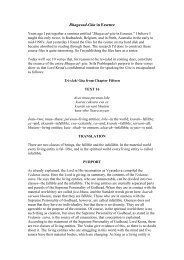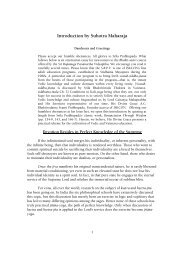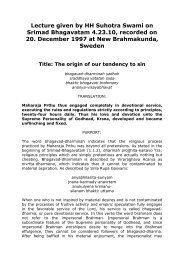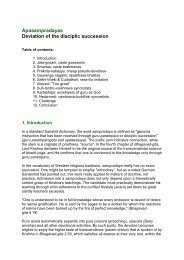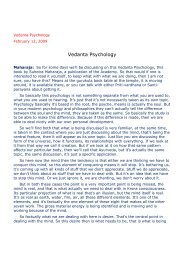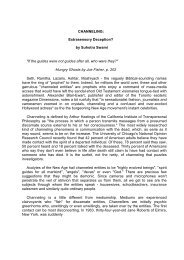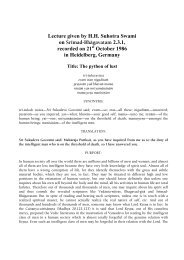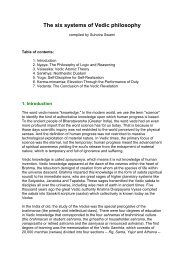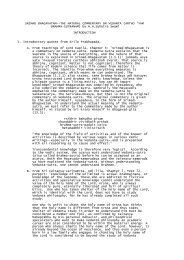What The Upanisads Teach.pdf - Suhotra Maharaja Archives
What The Upanisads Teach.pdf - Suhotra Maharaja Archives
What The Upanisads Teach.pdf - Suhotra Maharaja Archives
You also want an ePaper? Increase the reach of your titles
YUMPU automatically turns print PDFs into web optimized ePapers that Google loves.
When the material creation up to the world of four-faced Brahma is destroyed, theygo with the ruler of the material world, the four-faced Brahma, from that createdworld to the Supreme Brahman, who is different from the four-faced Brahma.Srila Vyasadeva notes in Vedanta-sutra 4. 3. 4, ativahikah tallingat, that arcis, ahasand the rest are divine personalities who assist the soul along the arciradi-marga.<strong>The</strong> two paths of pitryana and devayana or arciradi-marga are summarized by LordKrsna in Bhagavad-gita 8. 23-26.O best of the Bharatas, I shall now explain to you the different times at which,passing away from this world, the yogi does or does not come back.Those who know the Supreme Brahman attain the Supreme by passing away fromthe world during the influence of the fiery god, in the light, at an auspicious momentof the day, during the fortnight of the waxing moon, or during the six months whenthe sun travels in the north.<strong>The</strong> mystic who passes away from this world during the smoke, the night, thefortnight of the waning moon, or the six months when the sun passes to the southreaches the moon planet but again comes back.According to Vedic opinion, there are two ways of passing from this world, one inlight and one is darkness. When one passes in light, he does not come back. Butwhen one passes in darkness, he returns.It would seem from these Gita verses and from the upanisads that Lord Krsna refersto here that time is an important deciding factor in the attainment of liberation.Apparently, anyone who dies during the night or during the six months when the sunpasses in the south must return to this material world.In Govinda-bhasya Srila Baladeva Vidyabhusana makes this comment:<strong>The</strong> yogis, that is, they who are devoted to the Supreme Personality of Godhead, donot take these descriptions of the passing of the moon, the light, and other points intime very seriously. <strong>The</strong>y merely make a mental note of them (smaryate). <strong>The</strong> sutraexplains, ete smarte (they are remembered). <strong>The</strong> Supreme Lord explains inBhagavad-gita (8. 27):naite srti partha jananyogi muhyate kascanaAlthough the devotees know these two paths, O Arjuna, they are never bewildered.<strong>The</strong> conclusion is that a person situated in transcendental knowledge need not beconcerned about the specific time of his death. <strong>The</strong> mention of specific times is notprominent in this passage from Bhagavad-gita (8. 23-26). <strong>The</strong> passage begins withthe mention of fire, which has nothing to do with time. In fact, the different factorsmentioned in this passage are all ativahika- devatas (demigods that carry the soulfrom the body). <strong>The</strong> author of the sutras will explain this in sutra 4. 3. 2. It is alsosaid:51



